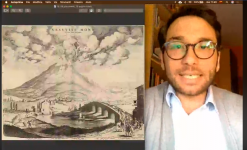The making of emergency response policies in Early Modern Age is the title of a streaming video by Gennaro Schiano for the cycle of cultural events Non fermiamo la cultura (Do not stop culture) transmitted by the Department of Culture of Naples Municipality during Covid-19 lockdown on 9th April 2020.
Through images and texts printed during the Early Modern Age, Schiano explains that the relaciones de sucesos narrating natural disasters are among the most widespread news at that time.
News written, read, copied, translated, updated, republished years later in numerous examples shows how information on natural disasters circulated widely in the territories of the Spanish Empire between the sixteenth and eighteenth centuries.
Studying this circulation gives us the opportunity to understand how the news about environmental calamities takes on an unprecedented cultural and social value, far from the merely geological and physical dimensions of the past.
In fact, earthquakes, floods, fires and other types of disasters are social events that provide a sort of photographic negative relevant to the culture and the imaginary of the period in which they took place.
They are unexpected and sudden events that pierce the veil of everyday life, discovering, on one hand, how they used to live, what they were afraid of, and how they conceived of and imagined life and death, and, on the other hand, the logic according to which power faces and manages crises.
For all these reason, there is an extraordinary need to report, tell and disseminate exceptional events.






Leave a Reply
Want to join the discussion?Feel free to contribute!